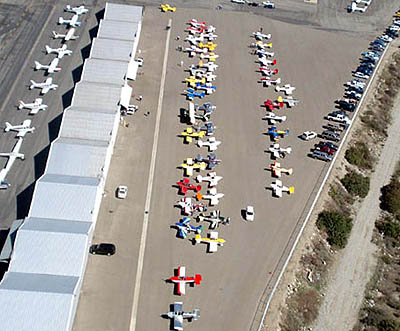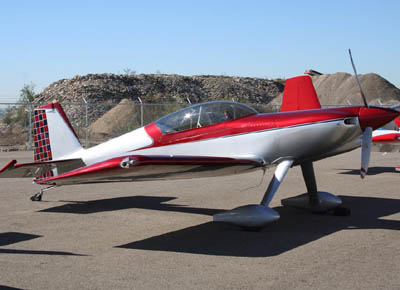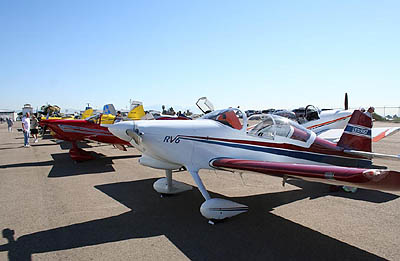User fees. TFRs. High fuel prices. Increasing regulation. A tight insurance market. It seems everywhere we turn these days, there’s a new challenge for general aviation. And that goes double for the aerobatic community, which by its very nature has additional noise and public relations issues with which to contend. IAC membership is down. Here in Southern California, we’re being relegated to ever smaller and more distant chunks of airspace in which to legally do our “thing”.
How depressing! There are days when I question whether this avocation of ours will survive. So it was with great pleasure that I accepted an invitation last month to present a seminar on aerobatics at the Socal RV Rendezvous, a regional gathering of homebuilt RVs. Fifty seven aircraft and more than 100 people showed up. The event coincided with IAC’s recent push to be more inclusive of recreational aerobatics, and the RV Rendezvous reinforced in my mind the wisdom of that shift.

According to Vans Aircraft, 5,024 RV-series airplanes have been built and flown thus far. Thousands more are under consruction around the country, and the rate at which they are achieving flight status is increasing rapidly as the build time drops.
Aside from the 350 RV-9/10 models, every one of those 5,024 airplanes is designed for aerobatic flight. This represents the largest aerobatically capable fleet in the world. Compare these 5,000 RVs to perhaps the most ubiquitous competition aircraft, the Pitts. According to Aviat, approximately 700 factory built and 600 homebuilt aircraft are in that fleet worldwide. The Extra? I counted 258 of those on the U.S. registry.
I’ve been involved with the RV community since a friend of mine started building his RV-7 in 2001. I pounded rivets on his plane and had a chance to watch one come together from the ground up. My general impression is that these aircraft are quite conventional and well designed.
I’ve flown the RV-4, RV-6, RV-7, and RV-8. I wouldn’t consider them to be especially well suited for competition, primarily because the clean design, flush riveting, and careful fairing of the draggy bits mean the airspeed will build quickly when pointed downhill. That’s not to say they cannot be flown in competition. They can, and they have been. You’d just have to work harder to ensure the airplane’s limitations are not exceeded.
When you get to recreational aerobatics, that’s where the RV shines. RVs are light in roll but somewhat heavier in pitch. Reminiscent of a Pitts, though not quite as heavy in the lateral axis. A true pleasure to fly. They actually gain altitude throughout most sequences, something you don’t often see in airplanes with 160-200 horsepower.
Speaking of drag, an aerobatic flight in an RV will open your eyes to just how draggy most of our competition airplanes are! All that horsepower under the cowl of your S-2B or Sukhoi is designed for vertical penetration. Speed is, to a certain extent, an enemy when you’re competing. It will carry you through the box too quickly. The RV was designed for speed because they are used for cross country transportation. Put that 300 hp engine in an RV and it will go a lot faster than any Extra 300, Edge 540, or Velox.

I’ve flown a wide variety of Sportsman-level maneuvers in RVs, and they perform remarkably well as long as the energy is properly managed. Spins, aileron rolls, loops, immelmans, cubans, hammerheads, barrel rolls, and the split s are easily done in an RV within a +3.5/-0G range. This is well within the designer’s stated design limits of +6/-3G (and ultimate load factors +9/-4.5G). Airspeed limits such as Vne, Vno, and Va are high enough that RVs can fly through these maneuvers without danger of overspeeding the aircraft. Throttle management, unusual attitude training, and a clear understanding of the RVs slippery aerodynamics are key to safety in these birds.
Unlike certificated airplanes, RVs come in many flavors. Different engines, props, canopy styles, landing gear configurations, etc. Much like a Citabria, Stearman, or Cub, most of them do not have inverted fuel or oil systems, so I will modify maneuvers like the half Cuban by rolling upright as soon as the 45 degree inverted point is reached in the loop. Remember, we’re just talking about recreational aerobatics. These guys aren’t going to fly competition in their pride and joy. They just want to be able to safely perform basic figures.

On the topic of safety, my primary goal at the Socal RV Rendezvous was to encourage RV pilots seek out quality instruction before attempting acro in their aircraft. This is smart advice for any aspiring aerobat, but it’s especially true with the RV for two reasons: first, the aforementioned sleekness of the airframe. And second, builders are often out of the air completely for several years while they focus on construction. Their Phase One flight testing may have been prepared for with recurrent flight training, but very infrequently does that training include aerobatics. Yet aerobatics must be included in the flight testing if it’s going to be added to the approved maneuvers in the airplane’s operating limitations.
On the way home, I couldn’t help but marvel at the strength and energy in the RV community. We could use a little of that in our local IAC chapter, don’t you think? There are five thousand of them out there, so let’s start recruiting! And if you have the opportunity to take an aerobatic flight in an RV, don’t pass it up. I’ll bet you’d be pleasantly surprised with what those little kit planes are capable of.

Hi,
Thank you for publishing this article it was very interesting.
I am considering buying a RV. There are many for sale today; what do you believe would be the best configuration for aerobatics. ie, tricycle gear (slow the airplane), constant speed prop…?
Also if you don’t mind, what other airplane may be a better choice – in the range of cost of an RV but a better airplane for aerobatics?
Thanks again,
Brian.
Hi Brian! Congratulation on your pursuit of a good RV. You’re right — the market is full of them right now.
Regarding your first question, as it concerns aerobatics, the landing gear configuration doesn’t matter at all. I believe the speed difference is one or two mph according to Van’s numbers. The only time you’ll notice a difference between the conventional and nosewheel gear is on the ground.
I would recommend a constant speed prop if you can afford it. It will mostly eliminate any concerns about overspeeding the engine, and you’ll get maximal performance whether in cruise or performing aerobatics.
If you get a fixed pitch prop, that’s fine too. I’ve done plenty of acro in fixed-pitch RVs, and even with the 320 cubic inch engine, the plane has plenty of performance for recreational aerobatics.
As to your question about a “better airplane” for aerobatics, if you want something that’s more of an aerobatic plane that can cruise (as opposed to an RV, which I think of as a cruiser than does aerobatics), I’d recommend a Decathlon or Super Decathlon.
Good luck in your search! –Ron
Hi Ron,
We are doing Sportsman Competition in our RV-4…and was wondering how it compares to an RV-8 ..also with an 180 H.p. Lycoming..?
An RV-4 with a 180 h.p. powerplant is going to perform roughly the same as an RV-8 with the same engine in competitive aerobatics.
The -4 may have a slight advantage since they tend to be a little lighter than the -8s, but you won’t notice it much because the Sportsman level sequences don’t have figures which require any significant vertical performance (ie. vertical rolls, vertical snaps, etc). The figures which *are* vertical are simple line segments, and the length of those lines is up to the competitor.
A good summation of the RV and aerobatics. We in Australia struggle with aerobatic numbers, so getting the homebuilt community involved seems an obvious way to go. But doing it safely is the trick. I flew comp in my RV-4 for a few years up to Sportsman level. Absolutely no problems, but you have to aggressively control the airspeed. As a rule whenever the nose is below the horizon, the power goes to idle. Keep the speed below 150KIAS, 140 preferably. A CS prop would make this aspect easier.
fly safe, and keep the rubber side up!
Hello I have a 6 a rv and I need to know the speeds of the acrobatic maneuvering inputs to do them with an instructor, it has a lycoming 150 hp thank you and hug